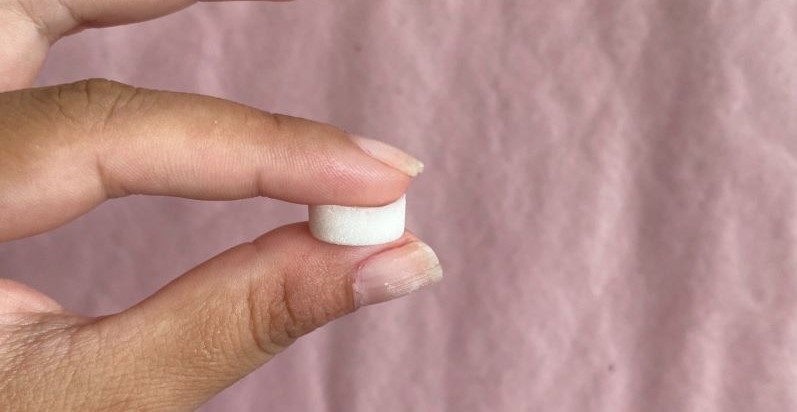


The sponge is made of materials that are biocompatible with vaginal tract cells, and the gel produced by contact with fluid in the region dissolves, so that there is no need for removal after the treatment, in contrast with polyurethane devices (photo: Fiama Martins)
Published on 01/08/2024
By Julia Moióli | Agência FAPESP – A biodegradable sponge made of chitosan, a biopolymer derived from the shells of crustaceans, releases medication slowly into the organism and makes treatment of candidiasis more comfortable and effective, judging from the results of tests performed by researchers at the University of Porto in Portugal and the Federal University of São Paulo (UNIFESP) in Brazil. An article describing them is published in the International Journal of Pharmaceutics.
Vulvovaginal candidiasis is one of the most prevalent infections of the female genital tract, estimated to affect some 75% of all women at least once in their lifetime. It is caused by fungi of the genus Candida, a type of yeast, and its symptoms include itching, burning, swelling, redness, and a thick white discharge.
It is usually mild but can become severe, affect other organs and even recur after a course of treatment, impairing the quality of the patient’s life. The available treatments are often disagreeable as they include creams and vaginal suppositories, and their efficacy is easily compromised by untimely administration.
“We developed a sponge that combines the comfort of a soft material with ease of use and the efficacy of the available medications,” said Fiama Martins, first author of the article and a researcher in the Department of Chemistry (DQ-UFSCar).
Its functioning is simple and similar to that of the intrauterine device (IUD) or coil used for decades as a non-hormonal contraceptive method. Thanks to its porous structure, the sponge absorbs a large amount of clotrimazole or other antifungal creams widely used for topical management of vulvovaginal candidiasis, which it releases slowly and steadily at normal body temperature and pH. One of the advantages is that the sponge can be inserted into the vagina by the patient herself.
“Our in vitro trials with vaginal tract cells showed activity of the medication against six different strains of Candida, full release within four hours, and bioequivalence between the free drug and the drug loaded into the sponge, demonstrating its effectiveness as a release system for clotrimazole,” Martins said.
Another advantage is that the device is made from biocompatible materials (chitosan and polyvinyl caprolactam) that rapidly absorb vaginal fluid and form a gel that erodes in four to eight hours, making removal unnecessary, in contrast with polyurethane devices, for example.
The researchers tested various types of sponges and also compared the anti-fungal activity of various drugs with and without sponges, confirming that the sponge material did not adversely affect the action of the drugs.
Commercial product
“The study showed that novel devices can be designed with improved biopharmaceutical properties and acceptability for patients, which is fundamental for public health,” said Emerson Rodrigues de Camargo, co-corresponding author of the article and a professor at DQ-UFSCar.
The study was supported by FAPESP under the aegis of the Center for Development of Functional Materials (CDMF), a Research, Innovation and Dissemination Center (RIDC) funded by FAPESP and hosted by UFSCar.
“The study combined basic science, which looks for answers to general questions, and applied science, which addresses specific questions and leverages knowledge to achieve short-, medium- and long-term social benefits. Neither can exist without the other,” Camargo said.
According to the researchers, the next step will be to conduct clinical trials, aimed among other things to assess use of the device with anti-inflammatory and wound healing medications to treat other diseases besides candidiasis. The possibilities include filling the ocular cavity in cases of eye loss to prevent facial muscle atrophy and impairment of the ability to chew, with the advantage over prosthetics of administering medication to prevent infection, Camargo explained.
“We expect the chitosan sponge to become a mass-produced commercial product in Brazil in the medium term and to cost less than imported products,” he said.
The article “Chitosan-based sponges containing clotrimazole for the topical management of vulvovaginal candidiasis” is at: www.sciencedirect.com/science/article/abs/pii/S0378517323009298?via%3Dihub.
Source: https://agencia.fapesp.br/50581